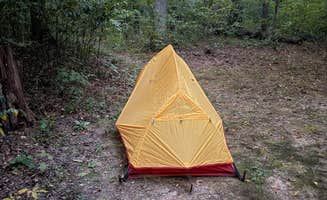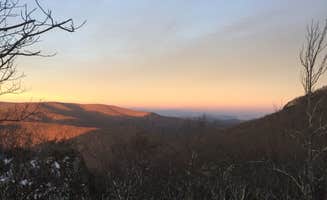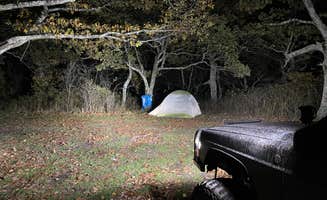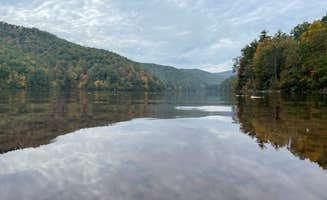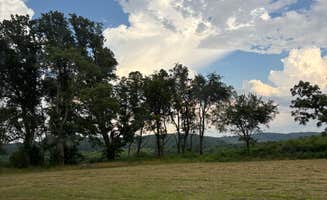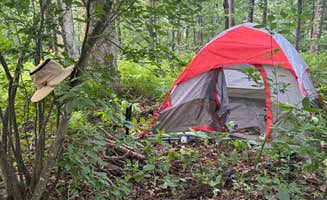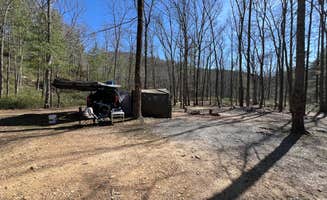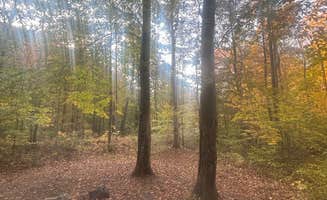Dispersed camping areas near Staunton, Virginia sit within the George Washington National Forest at elevations between 1,500-4,000 feet. The region receives approximately 44 inches of rainfall annually, creating seasonal water crossings at several primitive sites. Summer temperatures typically range from 60-85°F with cooler nights at higher elevations, while winter camping requires preparation for temperatures that can drop below 20°F.
What to do
Fishing opportunities: Braley Pond Dispersed Camping & Day Use Area offers stocked trout fishing with seasonal regulations. "The pond is stocked with trout in season, check DGIF site for dates," notes camper Paul P. Several sites feature stream access for additional fishing options.
Trail exploration: Multiple hiking options connect primitive campsites to longer routes. At Spy Rock, "You hike in and there is a decent sized area to set up tents. Scramble up to the top for amazing sunsets and sunrises," according to Rob U. Some visitors opt for the shorter 1.5-mile route from Montebello Fish Hatchery rather than the longer Crabtree Falls approach.
Solitude seeking: Weekday camping provides the best chance for isolation. "I was the only one here on a Saturday night. Very quiet and it was great to have the place to myself. I took advantage of the trails in the morning," reports Austin K. about his Braley Pond experience. Many sites remain uncrowded Monday through Thursday even during summer months.
What campers like
Creek-side camping: Many sites feature proximity to flowing water. At George Washington National Forest off 812, "There are 6-8 different sites, all are beautiful and most are right next to the creek. There was a fire ring and man made stone oven at the site we chose," shares Sawyer B. Stream access provides both ambient sound and practical water for filtration.
Night sky viewing: Minimal light pollution creates exceptional stargazing conditions. "The stars were amazing! There was plenty of wood scattered about to use as firewood," notes Austin K. about his Braley Pond experience. Higher elevation sites like Flagpole Knob offer unobstructed celestial views when weather permits.
Rock features: Natural formations create interest at multiple sites. Switzer Lake Dispersed Camping visitor Mike C. describes "tons of very primitive spots and privacy" with unique rock features throughout the camping area. Sites with established fire rings often incorporate natural stone elements.
What you should know
Vehicle requirements: Many dispersed sites demand specific vehicle capabilities. For Flagpole Knob, David B. warns "This site requires a 4x4 vehicle with clearance. The trail leading to and from camp can be a bit tricky for some." Even sites accessible by standard vehicles can become challenging after precipitation.
Cell service limitations: Communication options remain minimal across most sites. "There is no cell signal here (at least with Verizon as of 3/2020)," notes Dave P. about Braley Pond. Campers at Switzer Lake report similar connectivity constraints, with service only available by driving several miles toward main roads.
Weather considerations: Conditions change rapidly at higher elevations. Adrian F. advises at Flagpole Knob, "If you know it's going to be windy don't camp at the peak. There's plenty of camp spots close by with some cover from trees." Low-lying areas near water present different challenges, potentially becoming saturated after heavy rainfall.
Tips for camping with families
Kid-friendly fishing: Stocked waters provide reliable catches for young anglers. Amy S. shares about Poor Farm Dispersed Recreation Area: "Really enjoyed this place. Maybe 5-10 min off of highway 220. There are maybe 5 ish spots to camp next to a river in this mountain valley." Accessible fishing opportunities work well for families with children.
Stream exploration: Shallow water features offer natural play areas. "Though you can't swim in the lake, we did wade the stream, which was cold and clear and beautiful," Amy S. reports about her family trip to Braley Pond. Sites with gentle water access points provide natural cooling during summer months.
Wildlife viewing: Dawn and dusk bring animal sightings at many locations. The open meadow at Poor Farm Dispersed Recreation Area becomes "covered in wild hares" during spring months according to Clayton S. Campers should secure food appropriately as bears have been reported at multiple sites.
Tips for RVers
Access evaluation: Primitive sites require careful assessment for larger vehicles. At Reservoir Road Dispersed Campsite, SJ W. cautions about "about 5 miles of dirt road to get to it" that proved "questionable for my van." Most dispersed sites accommodate smaller RVs only.
Turnaround availability: Limited maneuvering space creates challenges at many locations. Derek D. notes that Reservoir Road offers "multiple spots along reservoir rd" but advises checking turnaround capacity before committing to the narrower sections of the route.
Leveling challenges: Natural terrain rarely provides perfectly flat parking. RV campers report using additional leveling blocks at most sites, with forest roads frequently featuring cross-slopes that require compensation. Staying closer to main access roads typically provides more level options than remote sites.


